‘Built Beyond Belief’ is the tagline for Kawasaki’s latest speed demons – the Ninja H2 and H2 R. A test of these two incredible machines underlines that claim, as they absolutely set the track on fire at the Losail circuit in Qatar. Under the lights, the night recorded a maximum speed of 330km/h. Enough said!
The Ninja H2, the latest big bike by Kawasaki, is something that simply shouldn’t exist on this planet. There is no compelling reason to buy it. In Japan, they have been working for years to deliver this monster to the world of motorcycling – but why this absurdity? Perhaps it’s because we’re human beings with our weaknesses and passions, and perhaps as bikers we are nothing if not grown up kids who never stopped playing. The H2 is a fantastic toy – something to show off with pride to our friends and polish every night before going to sleep. And if you are able to own an H2 R, your emotional quotient will be on a different plane altogether.
FOR A VERY FEW
The specifications for both the bikes are well known. Powered by a supercharging system, the road legal H2 belts out 200bhp – while the H2 R, which is meant only for closed course riding, has an output of more than 300bhp.
Both these motorcycles seem to have touched the pinnacle of technology at Kawasaki – a company that also designs and manufactures boats, satellites, rocket ships, robots, etc. What we wanted to find out is what kind of emotion one feels astride these new big bikes. This is something of primary importance in a segment that’s typically focused only on lap times – with bikes that require expert riders for optimum results.
In the past, we’ve already listed – in an in-depth technical analysis – the technical differences between the H2 and its ‘evil’ version, the H2 R. What has not been spoken of as yet, however, are the several differences between the two bikes in terms of their visual details. In the R version, carbon fibre has been used in profusion for the fairing, and the rear view mirrors have been replaced by two deflectors that couple the ones on the side of the fairing wings. The whole structure is meant to improve the bike’s aerodynamics. And then there’s the front end, with two voracious intakes that – through the showy canalisation network – supply air to the impeller of the supercharging system (the H2 has only one intake). The sharp cowl design perfectly matches the shape of the (adjustable length) single-seat.
A STREET BIKE... FOR RACING
Our test at the Losail racetrack started with the street version – the H2 – and, we must admit, we were flabbergasted by the fact that we had to reset all the parameters built up thus far for the latest generation sports bikes. This is not just a new sports bike, but a sort of technological manifesto – and it needs to be viewed as such.
The H2 is not particularly light, so it’s not that fast when changing direction, but it’s extremely rigorous when it comes to following a particular line through a corner. It’s a sort of big sports-tourer in a futuristic shell. If any forceful attempt is made to mitigate its character, the chassis reacts with agitation and unpredictability. You need to calibrate its trajectory to the last centimetre, and be extremely smooth with your inputs. Indeed, the suspension struggles to deal with almost 240 kilos of mass – and the situation is complicated further by the addition of even more speed.
The power supplied by the four-cylinder Kawasaki engine is incredible. The torque is potent from 3,000rpm, and is exaggerated even beyond 11,000rpm. The thrust is titanic throughout the rev range, and the bike achieves incredible speeds – all you have to do is twist the throttle and fly. However, when you want to make small openings in the middle of a bend, the throttle response can often be too sharp – which breaks the fluidity through a bend. Besides, the massive torque puts a lot of stress on the rear suspension and tyre. The main reason for this is the near lack of any electronic devices on the bike. The traction control does whatever it can – but it’s not always punctual in managing the loss of grip, and therefore, is of little assurance to the rider. It simply isn’t a reliable partner when the going gets tough. In this mix of feelings and sensations, the H2 really seems to fly – to the extent that, at the end of the Losail straight, the instrument cluster shows a reassuring peak speed of 299km/h.
A HURRICANE OF SENSATIONS
When you start the H2 R to warm up the engine, it gives you goose bumps. Partly because of the noise – only a MotoGP bike is able to impress in the same way – and partly because we’re hesitant to manage an H2 with an extra 100bhp.
The four-in-one exhaust, without a silencer, gives voice to the 310bhp engine of the H2 R – which shatters the silence of the Arabian desert with a scary, exciting, endless scream. The bike becomes part of me, it troubles me, shaking my nervous system and almost dismantling my skeleton. It takes me a while to concentrate, and start feeling comfortable enough to open the throttle.
Luckily, the feeling of control improves. But now, with every minimum rotation, a hurricane of torque of rages forth. In the best case, you’re constantly flying at absurd speeds. In the worst case, the front end points skywards and there’s simply no coming back. And so it’s inadvisable to rev beyond the 11,000rpm mark in second and third when coming out of a bend.
It needs guts to keep going, and open it up on the straight. Fourth, fifth and sixth gears are dismissed in an instant, with the display showing 14,000rpm and 320km/h – with a peak of 330km/h. It’s delirium! The striking thing is that, weighing 20kgs less, it produces a miracle. The bike can definitely be handled with a lot more confidence. It’s simply better from every point of view – gaining precision, stability and safety.
It’s a pity that the electronics are not at the same level. The traction control does whatever is in its power (which is very little), and then there’s still the minor problem relating to rear tyre consumption – which, after six or seven laps, needs to be thrown away. But that would be insignificant for anyone who has 50,000 Euros in his pocket to afford this toy. In India, the H2 can be yours for 29 lakhs. The H2 R, unfortunately, is not for sale.
Forced Induction
The big innovation, introduced with the H2 and the H2 R, is supercharging – a small revolution in the world of sports bikes (obviously if we exclude the timid attempts made by the Japanese manufacturers in the early 1980s with the Kawasaki Gpz 750 Turbo, the Honda CX500, the Yamaha XJ 650 and the Suzuki XN85). But what is supercharging? Simple. In an endothermic engine, it consists of forced introduction of the air/fuel mixture in the combustion chamber – while a normal powertrain simply exploits atmospheric pressure. To supercharge an engine with the goal of increasing the specific power, air is normally compressed in the suction ducts and the quantity of fuel ‘sprayed’ by the injectors is regulated. The resulting blend in the combustion chamber has greater explosive power – with significant increases in both power and torque.
There are two main supercharging systems – the turbocharger and the volumetric compressor. The first, characterised by a turbine and an impeller seated on the same shaft, exploits the kinetic energy of the exhaust gases expelled from the combustion chamber. The second features only an impeller (the compressor) placed in rotation by a belt connected to the driveshaft. The latter is the system adopted by the Kawasaki on the H2 and the H2 R.
The centrifugal compressor of the H2/H2 R – a magnificent impeller in aluminium alloy, with a diameter of 69mm, milled from billet aluminium by high-precision CNC machines, and endowed with six long and six short blades – revolves at a speed that is directly proportional to the crankshaft, and it features an optimum and quite limited operating range. The maximum efficiency is obtained at very high rotational speeds, while at medium and low rotations the contribution of the system is negligible. For this reason, between the impeller and the driveshaft, a planetary gear unit has been installed that has a multiplication ratio of 8:1 (which becomes 9:2 if we also take in account the belt’s ratio). This means that whenever the H2 rotates at 14,000rpm, the compressor reaches a speed of 1,30,000rpm!
According to the data furnished by Kawasaki, the supply pressure can touch up to 2.4 bar without any major issues related to the overheating of the compressed air forced into the suction ducts (as happens with turbocharged engines). Nevertheless, to keep the air temperature under control, and to resist the higher pressure that forms inside, the air-box is made of aluminium, which enhances the heat dissipation. It also proves to be more resistant than plastic. The whole supercharging system is supplied by a long and linear intake duct, which connects the impeller with two huge spouts placed on the front fairing. To give you an idea of their dimensions, these cover a third of the frontal section of the fairing (in H2, one of the two air intakes is closed).
The compressor is powered by the motor shaft, multiplied by the so-called ‘planetary stage’ (photo bottom left). When the engine is at 14,000rpm, the impeller rotates at a speed of 1,30,000 rpm! In the engine design below, the turbine (in the red crankcase) is what compresses the air into the air-box
How to go from 200 to 310 HP…
The engine of the H2 and H2 R, other than the supercharging system, is a classic inline 4-cylinder unit – obviously ‘dimensioned’ and designed to support the significant power that it develops, and to resist to the high temperatures that it has to withstand.
Other details are also noteworthy. The pistons, for instance, are not forged – as is usually the case for these types of bikes – but they’re fused and have flatter crowns to optimise the shape of the combustion chamber. Distribution is twin cam with four valves per cylinder. The two inlet valves are made of steel. The exhaust valves – stressed by the high temperatures due to the supercharger – are composite.
One of the main problems that the Kawasaki technicians have to deal with is operating temperature. To dissipate the heat generated in the combustion chamber, the cylinders and head are characterised by a wide network of refrigerant pipes – more abundant than what we see in a 4-cylinder in-line naturally aspirated engine of the same capacity. The exhaust ducts are double for each cylinder (one per valve). Even the engine oil plays an important cooling function. Below each piston, for instance, there are two jets that spray oil, instead of the single one that’s normally the case. The differences between the H2 and H2 R engines are mainly centred around the electronic engine management, which restricts the H2 to 200bhp (at 11,000rpm), as well as the exhaust system. The camshafts are different, and so is the compression ratio (8.3:1 for the H2, compared with 8.5:1 for the H2 R).
Another slight modification concerns the value of the final drive, which is obviously longer for the powerful H2 R. On the H2 R, the clutch is more solid – since it has to bear with around 100bhp extra. The frame is quite peculiar. The steel tubular Trellis frame is, indeed, quite rare for Japanese manufacturers of big sports bikes. Even this choice aims at the maximum possible heat dissipation.
Brakes and suspension follow the standards set for sports bikes. The front calipers are single billet by Brembo, the monoshock and the forks are by KYB. The dimensions of the rear tyre changes from the H2 to the H2 R. The former features a 200/55 tyre, while the latter gets a 190/65 tyre. The expansion of the tyre shoulder also produces slight variations in what we consider the standard dimensions.
The electronics follow the road taken by the Ninja ZX-10R. The rider can choose amongst three riding modes specifically designed for the H2 and the H2 R. In each mode, it’s possible to program the action of the KTRC traction control (Kawasaki Traction Control) on three different operation modes. This one is of predictive typology, and it works thanks to an algorithm that reads the signals received by the engine and the tyres (the bike lacks an inertial platform). The electronics also define the launch control (KLCM), the electronic motor brake (KEBC), and the KIBS (Kawasaki Intelligent anti-lock System) sport ABS.
The front of the ‘R’ is aggressive, without a headlamp and displaying an impressive set of air intakes. Below, the details of the H2 street version, which has a very modern ‘control station’ – which is yet traditional when compared with the rest of the bike…
KAWASAKI NINJA H2 (H2 R)
Engine
4-cylinders inline, 998.0cc,
Bore x stroke: 76.0x55.0mm, liquid cooled, compression ratio 8.5:1 (8.3:1), double overhead camshafts, 16 valves, electronic injection with 4 throttle bodies, full 50mm RbW and volumetric compressor, wet sump lubrication.
Transmission
44/18 (42/18) Chain final drive; slip assist multi disc wet clutches; 6 speed gearbox with hydraulic control, rider manageable electronic controls, 4 (3) engine maps; three level KTRC traction control system; KLCM launch control KLCM; KEBC electronic motor brake
Frame
Steel tubular trellis frame, 24.7° (25.1°) steering head angle, 108.0mm trail; fully adjustable 43mm inverted fork mounts; aluminium single arm and fully adjustable shock absorber; 120/135mm wheel travel
Brakes
330mm two disc front brake, 4 piston radial mount calipers; 250mm rear brake, dual piston caliper
Tyres
120/70-ZR17
(120/60-R17) front tyre;
200/55-ZR17
(190/65-R17) rear tyre
Dimensions (mm)
Width 770, wheelbase 1,455 (1,450), saddle height 825 (830),
17.0 ltr tank, dry weight 238 (216) kgs
Declared performance
147.2 kW – 200bhp at 11,000rpm,
(228.0 kW – 310bhp at 14,000rpm);
133.5Nm - 13.6kgm at 10,500rpm
(165.0Nm - 16.8kgm at 12,500rpm)
Available colors
black, carbon black
Pros
Performance
Power output
Braking
Cons
On-off throttle control
Weight (H2)
© Riproduzione riservata



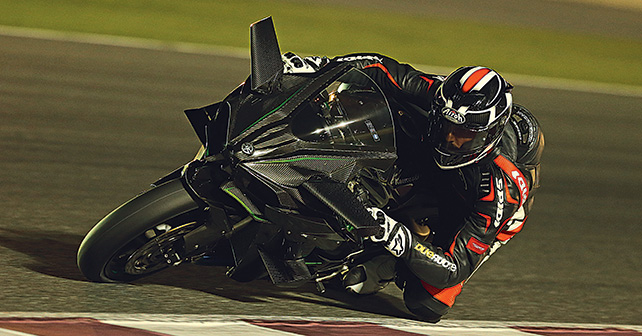
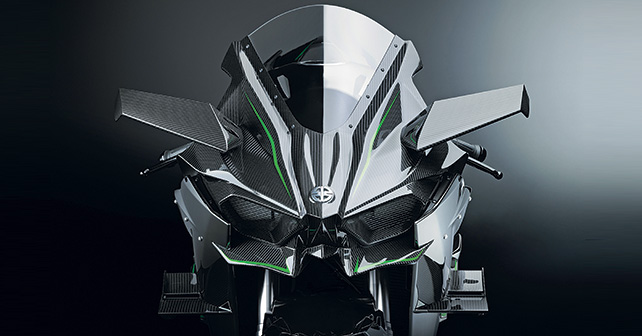


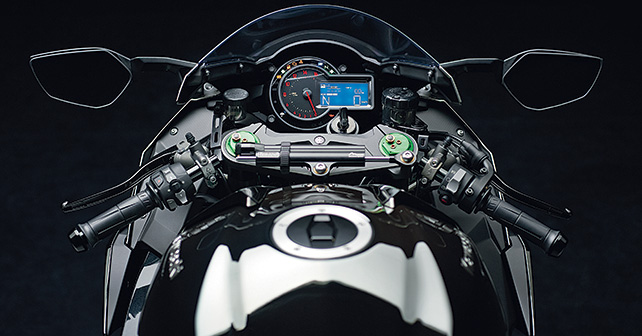








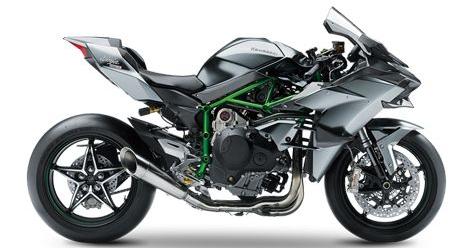
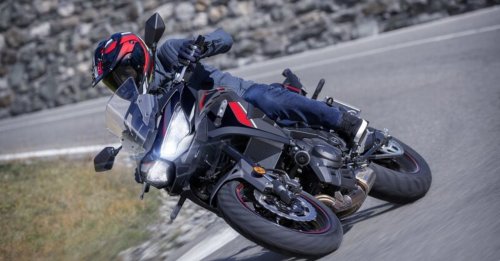




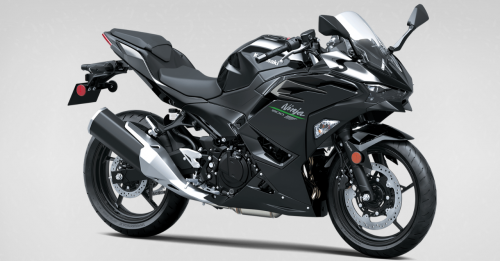














Write your Comment